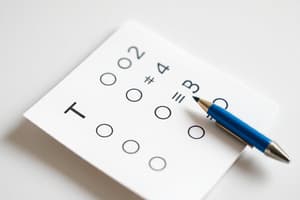Podcast
Questions and Answers
Which group of muscles of the larynx is further divided into two subgroups?
Which group of muscles of the larynx is further divided into two subgroups?
- Extrinsic muscles (correct)
- Depressors of the larynx
- Intrinsic muscles
- Elevators of the larynx
Which muscles are also called strap muscles because of their flat shape?
Which muscles are also called strap muscles because of their flat shape?
- Elevators of the larynx
- Extrinsic muscles (correct)
- Intrinsic muscles
- Depressors of the larynx
Which muscles control the laryngeal inlet?
Which muscles control the laryngeal inlet?
- Extrinsic muscles
- Intrinsic muscles (correct)
- Elevators of the larynx
- Depressors of the larynx
Which muscles control the movements of the vocal folds?
Which muscles control the movements of the vocal folds?
What is the composition of a muscle's name based on?
What is the composition of a muscle's name based on?
What does the action of a muscle indicate?
What does the action of a muscle indicate?
What is the term used for the muscles that elevate the larynx?
What is the term used for the muscles that elevate the larynx?
What is the term used for the muscles that depress the larynx?
What is the term used for the muscles that depress the larynx?
Which group of muscles is usually very informative in terms of their nomenclature?
Which group of muscles is usually very informative in terms of their nomenclature?
What is the name of the muscle that extends from the sternum to the hyoid bone?
What is the name of the muscle that extends from the sternum to the hyoid bone?
Which muscles bring the arytenoids and the aryepiglottic folds closer to each other, narrowing the laryngeal inlet?
Which muscles bring the arytenoids and the aryepiglottic folds closer to each other, narrowing the laryngeal inlet?
Which muscle is responsible for increasing the length and tension of the vocal folds, leading to a higher pitch?
Which muscle is responsible for increasing the length and tension of the vocal folds, leading to a higher pitch?
Which muscle is responsible for decreasing the length and tension of the vocal cords, leading to a lower pitch?
Which muscle is responsible for decreasing the length and tension of the vocal cords, leading to a lower pitch?
Which artery supplies blood to the upper half of the larynx?
Which artery supplies blood to the upper half of the larynx?
Which artery supplies blood to the lower half of the larynx?
Which artery supplies blood to the lower half of the larynx?
Which nerve provides sensory innervation to the mucosa from the inlet to the glottis?
Which nerve provides sensory innervation to the mucosa from the inlet to the glottis?
Which nerve provides motor innervation to the cricothyroid muscle?
Which nerve provides motor innervation to the cricothyroid muscle?
Which nerve provides motor innervation to all intrinsic laryngeal muscles except the cricothyroid muscle?
Which nerve provides motor innervation to all intrinsic laryngeal muscles except the cricothyroid muscle?
Where do the lymph vessels drain from the larynx?
Where do the lymph vessels drain from the larynx?
Which nerve provides sensory and motor innervation to the larynx?
Which nerve provides sensory and motor innervation to the larynx?
Which muscle is responsible for elevating the hyoid bone upwards and backwards?
Which muscle is responsible for elevating the hyoid bone upwards and backwards?
Which muscle is responsible for depressing the hyoid bone and thyroid cartilage?
Which muscle is responsible for depressing the hyoid bone and thyroid cartilage?
Which muscle is responsible for bringing the hyoid bone down in the direction of the sternum?
Which muscle is responsible for bringing the hyoid bone down in the direction of the sternum?
Which muscle is responsible for providing stability for tongue movement during swallowing and contributing to hyoid elevation and mandibular depression when the hyoid is fixed?
Which muscle is responsible for providing stability for tongue movement during swallowing and contributing to hyoid elevation and mandibular depression when the hyoid is fixed?
Which muscle is responsible for elevation and forward traction on the hyoid bone?
Which muscle is responsible for elevation and forward traction on the hyoid bone?
Which muscle is considered a laryngeal elevator if contracted while the hyoid is fixed?
Which muscle is considered a laryngeal elevator if contracted while the hyoid is fixed?
Which muscle is responsible for depressing the hyoid bone?
Which muscle is responsible for depressing the hyoid bone?
Which muscle is responsible for depressing and retracting the hyoid bone?
Which muscle is responsible for depressing and retracting the hyoid bone?
Which muscle is responsible for closing the membranous glottis?
Which muscle is responsible for closing the membranous glottis?
Which muscle is responsible for closing the cartilaginous glottis?
Which muscle is responsible for closing the cartilaginous glottis?
Flashcards are hidden until you start studying
Study Notes
Laryngeal Muscles
- Intrinsic laryngeal muscles are further divided into two subgroups: extrinsic and intrinsic muscles.
- Strap muscles, also known as sternothyreoideus and thyreohyoideus, are flat in shape.
- Cricothyreoideus posterior and lateral cricoarytenoideus muscles control the laryngeal inlet.
- Vocalis, cricothyreoideus, and thyroarytenoideus muscles control the movements of the vocal folds.
- A muscle's name is composed of the origin and insertion of the muscle.
- The action of a muscle indicates its function.
- Elevators of the larynx are called laryngeal elevators, while depressors of the larynx are called laryngeal depressors.
- Intrinsic laryngeal muscles are very informative in terms of their nomenclature.
- The sternohyoideus muscle extends from the sternum to the hyoid bone.
Functions of Specific Muscles
- Aryepiglottic and interarytenoideus muscles bring the arytenoids and aryepiglottic folds closer, narrowing the laryngeal inlet.
- Cricothyreoideus muscle increases the length and tension of the vocal folds, leading to a higher pitch.
- Thyroarytenoideus muscle decreases the length and tension of the vocal cords, leading to a lower pitch.
Blood Supply and Innervation
- The superior laryngeal artery supplies blood to the upper half of the larynx.
- The inferior laryngeal artery supplies blood to the lower half of the larynx.
- The internal laryngeal nerve provides sensory innervation to the mucosa from the inlet to the glottis.
- The external laryngeal nerve provides motor innervation to the cricothyroid muscle.
- The recurrent laryngeal nerve provides motor innervation to all intrinsic laryngeal muscles except the cricothyroid muscle.
- The vagus nerve provides sensory and motor innervation to the larynx.
- Lymph vessels drain from the larynx into the deep cervical nodes.
Hyoid Bone and Related Muscles
- The digastric muscle elevates the hyoid bone upwards and backwards.
- The stylohyoid and hyoglossus muscles depress the hyoid bone and thyroid cartilage.
- The sternohyoideus and omohyoideus muscles bring the hyoid bone down in the direction of the sternum.
- The geniohyoid muscle provides stability for tongue movement during swallowing and contributes to hyoid elevation and mandibular depression when the hyoid is fixed.
- The mylohyoideus muscle elevates and performs forward traction on the hyoid bone.
- The stylohyoid and digastric muscles are laryngeal elevators if contracted while the hyoid is fixed.
- The omohyoideus and sternohyoideus muscles depress the hyoid bone.
- The thyrohyoid muscle depresses and retracts the hyoid bone.
Glottis and Related Muscles
- The lateral cricoarytenoideus muscle closes the membranous glottis.
- The interarytenoideus muscle closes the cartilaginous glottis.
Studying That Suits You
Use AI to generate personalized quizzes and flashcards to suit your learning preferences.




